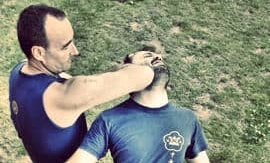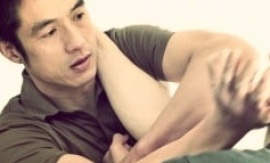
A RENOWNED CLOSED-DOOR DISCIPLE AND AMONG ONE OF THE FEW WHO HAVE COMPLETED THE ENTIRE WING CHUN SYSTEM UNDER IP MAN, GRANDMASTER HO KAM MING HAS DEDICATED HIS LIFE TO PROMOTING AND PRESERVING THE ART OF ORIGINAL WING CHUN. HOWEVER, ONLY A FEW HAVE BEEN PERSONALLY GROOMED BY GRANDMASTER HO KAM MING TO CARRY ON THIS MISSION.
One such Senior Disciple—Sifu Kiet Pham is the longest serving and practising disciple of GM Ho Kam Ming in Canada. Sifu Pham knows in full depth, GM Ho Kam Ming and his Wing Chun, and has himself dedicated his life to Chinese martial arts.
Could you briefly tell the readers about your martial arts journey?
I was born and grew up in Saigon, South Vietnam in a time of intensive warfare between North and South Vietnam. In the early 1970s, I began training in Vo Binh Dinh—a native Vietnamese martial art. After the Northern Communist regime took over the Southern Republic of Vietnam, I managed to stay for three more years. During that time, I began learning Vietnamese Wing Chun, also named Yuen Chai Wan Wing Chun. After several unsuccessful attempts to escape Vietnam, I finally landed in Malaysia as a political refugee and eventually settled in Canada in 1980. After an interruption of three years, due to my university education, I followed my martial arts passion and picked up my Wing Chun training again, but this time, it was under the lineages of Ip Man and Mainland China Wing Chun. During this time, I also embarked on Seven Star Praying Mantis, Plum Flower Praying Mantis Gung Fu, Chin Nah Shou Fa (the art of seizing and locking) and Chinese fast throwing (Kuai Shuai). In 1998, I met my last Wing Chun mentor, Grandmaster Ho Kam Ming and decided that Ho Kam Ming Wing Chun would be my major life-long martial art system. Ten years later, with the full encouragement and official authorisation of Grandmaster Ho Kam Ming, I founded the Bamboo Forest Wing Chun Martial Arts Academy to promote and preserve the valuable legacy of Ho Kam Ming Wing Chun in Canada.
With your diverse and extensive background in Chinese martial arts, what was your first impression of GM Ho Kam Ming’s Wing Chun?
When I first met GM Ho Kam Ming, I was neither impressed by his school nor was I convinced by the image of a 72-year-old man. I was full of prejudices about Hong Kong Wing Chun. I thought it was too commercialised and diluted. Also, with my martial arts skills and experience at the time, I could hold my own with some of GM Ho Kam Ming’s long-time private students. After four months of being relegated to a corner doing the basics as instructed, GM Ho Kam Ming called me over to begin Chi Sau with him. At first touch, even given all my previous diverse experience and intensive martial arts training, I realised that whatever my movements or how hard I tried, GM Ho Kam Ming was able to completely control my centreline and manoeuvre my balance. He manipulated and destroyed my structure and positioning, much like controlling a puppet. I was helpless under his control and completely in shock. Immediately, I realised I was at the mercy of a true Wing Chun Master. I awakened to the fact that all my previous prejudices were completely misguided and that I had just stroked the tiger’s whiskers. I finally met a true Wing Chun Master.
Can you provide some background on GM Ho Kam Ming?
GM Ho Kam Ming started Wing Chun training in the mid-1950s under GM Ip Man—first as a regular student and then as a closed-door private disciple. GM Ho stayed in touch with Ip Man until Ip Man’s death in 1972. Ip Man visited Ho Kam Ming’s Macao schools and observed instructions. They even conversed in person on the day of Ip Man’s death, which was shortly before Ho Kam Ming returned to Macao on a ferry. As Sifu Hawkins Cheung noted, “Ho Kam Ming began training when he was about 29 or 30 and therefore concentrated on theory. This is what he’s best at. He received all the best information.” (For more details, please refer to: www.wingchun.org/txt/misc/ hokaming.html) GM Ho Kam Ming is one of very few closed-door disciples to complete the entire Wing Chun system under Ip Man. He is highly regarded as among the top disciples of Ip Man. In the mid-1960s, he organised the Ho Kam Ming Wing Chun Association. He is an ex-Vice President of Ip Man’s Hong Kong Ving Tsun Athletic Association. Today, GM Ho Kam Ming is well-known in Macao, Hong Kong and Southern China. His full-contact Wing Chun team has fought in martial art tournaments in South East Asia with considerable reputation and success. GM Ho Kam Ming has devoted close to 60 years of tireless commitment to study, promote and preserve Wing Chun as passed down from many great Wing Chun masters before him.
Being the last generation of closed-door disciples to complete the system under GM Ho, what is your impression about him as a teacher and his approach to Wing Chun?
GM Ho Kam Ming is very traditional, strict and a perfectionist in the best sense of the word. He has stressed the utmost importance in cultivating strong Wing Chun foundations by practising all forms with minute-detailed precision. From the start, he emphasises developing control through patient and meticulous practice of the first form Siu Lin Tau. GM Ho said, “If you can’t control yourself, you can’t control others.” All Wing Chun principles and applications are developed in the art of Chi Sau. He never limited himself to only applications drills. The students are expected not to be greedy to learn too fast and are taught to take their time to learn the details until they are perfect and exactly to his satisfaction. He doesn’t hesitate in using harsh language if his students can’t understand or can’t perform certain movements as he wished. In the first few years of training, I felt GM Ho was too hot-tempered to the point that I made a decision to quit, only to reconsider my hasty decision, and subsequently return. (Laugh)
Can you share some fond memories of you and GM Ho Kam Ming?
Frankly speaking, besides the Wing Chun training at his school/private residence, I learnt the most from him during numerous one-to-one get-togethers to Yum Cha (drink tea/Dim Sum). During these private moments, I had the opportunity to ask and squeeze out many of his inner thoughts about Wing Chun theories. Most notably, whenever we touched upon Wing Chun subjects, GM Ho’s eyes brightened and his whole body and behaviour seemed to come alive. He would excitedly roam over many old stories related to various subjects of Wing Chun and his memories of his Sifu, Ip Man. He would provide in-depth details on the art of Wing Chun. On many occasions, to make his points clear, he would move a chair towards him. Seated facing each other, we did Chi Sau or he explained certain applications in the full view of spectators in a Chinese restaurant or Chinese coffee shop. This tells much about GM Ho Kam Ming as a person and his character as a true Wing Chun Master.
From your personal point of view, what is the proper way to develop true Wing Chun skills?
Rather than concentrating on physical sparring or training fixed patterns, it is better to concentrate on practising all three aspects of Wing Chun training: (1) Wing Chun foundations (forms, Wooden Dummy, weapons, Lop Sau, thorough mastery of five major Wing Chun principles in combat namely: control, balance, positioning, timing and distance fighting). (2) Wing Chun techniques that include those that are spontaneously developed before contact (distance fighting and go-in/entry fighting) and those developed after contact (Chi Sau). (3) Body energy/conditioning (punching bags, running, jumping, kicking techniques, etc.). When all of these aspects are good, the Wing Chun fighting will soon come naturally. Teaching is also an excellent process of learning.
Why do you focus on teaching natural response right from the start?
The art of combat must flow from the state of being and adapt to the opponent, to find the optimal position, in order to control and defeat the opponents via instantaneous actions. This is through years of constantly training Chi Sau, foundational development and conditioning. Combat is in a continual state of flux and is changeable at any moment. Hence, I do not teach fixed patterns to deal with flux that is both uncertain and in my opinion intangible.
Is Wing Chun a complete martial art?
Chinese martial arts are divided into four major categories: Ti (kicking), Da (striking), Shuai (wrestling, grappling), and Na (Chin Nah—the arts of seizing and locking). Wing Chun seamlessly deals with these functions. With proper foundational training, a Wing Chun practitioner is well prepared to deal with all ranges of combat. However, the expertise is still in a standing and as a close-range martial art system. A Wing Chun stylist should try to hold their ground as much as possible since it’s their main strength. However, if he/she has fallen on the ground, he/she should use all necessary tools such as Biu Chee recovery techniques and/or other foundational training to regain position and stand up as fast as possible. GM Ho Kam Ming used to say that as a Wing Chun stylist if you are brought to the ground during combat, it means your Wing Chun skills are not yet proficient. However, the martial arts environment is changing rapidly. Wing Chun should also adapt to the new environment. In my personal journey, I have extensively cross-trained with the circular approach of Praying Mantis Gung Fu, Chinese Chin Nah and fast combat throwing techniques (Kuai Shuai). I’m fascinated by these arts. However, regardless of this, I still consider Wing Chun as my major and life-long martial arts style.



















